Degradation of Butylated Hydroxyanisole by the Combined Use of Peroxymonosulfate and Ferrate(VI): Reaction Kinetics, Mechanism and Toxicity Evaluation
Abstract
1. Introduction
2. Materials and Methods
2.1. Chemicals and Water Samples
2.2. Experimental Procedures
2.3. Analytical Methods
2.4. Theory Calculations
2.5. Toxicity Evaluation
3. Results and Discussion
3.1. Degradation of BHA
3.2. Effect of pH on the Reaction
3.3. Effect of Water Constituents
3.4. Effect of Water Matrices
3.5. Identification of Main Reactive Species
3.6. The Reaction Pathway
3.7. Toxicity Evaluation
4. Conclusions
Supplementary Materials
Author Contributions
Funding
Institutional Review Board Statement
Informed Consent Statement
Data Availability Statement
Conflicts of Interest
References
- Zhang, R.; Li, C.; Li, Y.; Cui, X.; Ma, L.Q. Determination of 2,6-di-tert-butyl-hydroxytoluene and its transformation products in indoor dust and sediment by gas chromatography–mass spectrometry coupled with precolumn derivatization. Sci. Total Environ. 2018, 619–620, 552–558. [Google Scholar] [CrossRef] [PubMed]
- Liu, R.; Song, S.; Lin, Y.; Ruan, T.; Jiang, G. Occurrence of synthetic phenolic antioxidants and major metabolites in municipal sewage sludge in China. Environ. Sci. Technol. 2015, 49, 2073–2080. [Google Scholar] [CrossRef]
- Rodil, R.; Quintana, J.B.; Basaglia, G.; Pietrogrande, M.C.; Cela, R. Determination of synthetic phenolic antioxidants and their metabolites in water samples by downscaled solid-phase extraction, silylation and gas chromatography–mass spectrometry. J. Chromatogr. A 2010, 1217, 6428–6435. [Google Scholar] [CrossRef]
- Wang, Y.; Li, X.; Sun, X. The transformation mechanism and eco-toxicity evaluation of butylated hydroxyanisole in environment. Ecotoxicol. Environ. Saf. 2022, 231, 113179. [Google Scholar] [CrossRef] [PubMed]
- Soubra, L.; Sarkis, D.; Hilan, C.; Verger, P. Dietary exposure of children and teenagers to benzoates, sulphites, butylhydroxyanisol (BHA) and butylhydroxytoluen (BHT) in Beirut (Lebanon). Regul. Toxicol. Pharmacol. 2007, 47, 68–77. [Google Scholar] [CrossRef] [PubMed]
- Lee, M.-R.; Lin, C.-Y.; Li, Z.-G.; Tsai, T.-F. Simultaneous analysis of antioxidants and preservatives in cosmetics by supercritical fluid extraction combined with liquid chromatography–mass spectrometry. J. Chromatogr. A 2006, 1120, 244–251. [Google Scholar] [CrossRef] [PubMed]
- Sun, Z.; Yang, X.; Liu, Q.S.; Li, C.; Zhou, Q.; Fiedler, H.; Liao, C.; Zhang, J.; Jiang, G. Butylated hydroxyanisole isomers induce distinct adipogenesis in 3T3-L1 cells. J. Hazard. Mater. 2019, 379, 120794. [Google Scholar] [CrossRef]
- Yang, X.; Song, W.; Liu, N.; Sun, Z.; Liu, R.; Liu, Q.S.; Zhou, Q.; Jiang, G. Synthetic Phenolic Antioxidants Cause Perturbation in Steroidogenesis in Vitro and in Vivo. Environ. Sci. Technol. 2018, 52, 850–858. [Google Scholar] [CrossRef]
- Yang, X.; Sun, Z.; Wang, W.; Zhou, Q.; Shi, G.; Wei, F.; Jiang, G. Developmental toxicity of synthetic phenolic antioxidants to the early life stage of zebrafish. Sci. Total Environ. 2018, 643, 559–568. [Google Scholar] [CrossRef]
- Felter, S.P.; Zhang, X.; Thompson, C. Butylated hydroxyanisole: Carcinogenic food additive to be avoided or harmless antioxidant important to protect food supply? Regul. Toxicol. Pharmacol. 2021, 121, 104887. [Google Scholar] [CrossRef]
- Ye, Z.; Brillas, E.; Centellas, F.; Cabot, P.L.; Sirés, I. Electrochemical treatment of butylated hydroxyanisole: Electrocoagulation versus advanced oxidation. Sep. Purif. Technol. 2019, 208, 19–26. [Google Scholar] [CrossRef]
- Rodil, R.; Quintana, J.B.; Cela, R. Oxidation of synthetic phenolic antioxidants during water chlorination. J. Hazard. Mater. 2012, 199–200, 73–81. [Google Scholar] [CrossRef] [PubMed]
- Chu, W.; Lau, T. Ozonation of endocrine disrupting chemical BHA under the suppression effect by salt additive—With and without H2O2. J. Hazard. Mater. 2007, 144, 249–254. [Google Scholar] [CrossRef] [PubMed]
- Xiao, S.; Cheng, M.; Zhong, H.; Liu, Z.; Liu, Y.; Yang, X.; Liang, Q. Iron-mediated activation of persulfate and peroxymonosulfate in both homogeneous and heterogeneous ways: A review. Chem. Eng. J. 2020, 384, 123265. [Google Scholar] [CrossRef]
- Yang, Y.; Banerjee, G.; Brudvig, G.W.; Kim, J.-H.; Pignatello, J.J. Oxidation of Organic Compounds in Water by Unactivated Peroxymonosulfate. Environ. Sci. Technol. 2018, 52, 5911–5919. [Google Scholar] [CrossRef]
- Zhou, Q.; Song, C.; Wang, P.; Zhao, Z.; Li, Y.; Zhan, S. Generating dual-active species by triple-atom sites through peroxymonosulfate activation for treating micropollutants in complex water. Proc. Natl. Acad. Sci. USA 2023, 120, e2300085120. [Google Scholar] [CrossRef]
- Ghanbari, F.; Moradi, M. Application of peroxymonosulfate and its activation methods for degradation of environmental organic pollutants: Review. Chem. Eng. J. 2017, 310, 41–62. [Google Scholar] [CrossRef]
- Antoniou, M.G.; de la Cruz, A.A.; Dionysiou, D.D. Degradation of microcystin-LR using sulfate radicals generated through photolysis, thermolysis and e−transfer mechanisms. Appl. Catal. B Environ. 2010, 96, 290–298. [Google Scholar] [CrossRef]
- Mahamuni, N.N.; Adewuyi, Y.G. Advanced oxidation processes (AOPs) involving ultrasound for waste water treatment: A review with emphasis on cost estimation. Ultrason. Sonochemistry 2010, 17, 990–1003. [Google Scholar] [CrossRef]
- Zhang, B.-T.; Zhang, Y.; Teng, Y.; Fan, M. Sulfate Radical and Its Application in Decontamination Technologies. Crit. Rev. Environ. Sci. Technol. 2014, 45, 1756–1800. [Google Scholar] [CrossRef]
- Huang, W.; Xiao, S.; Zhong, H.; Yan, M.; Yang, X. Activation of persulfates by carbonaceous materials: A review. Chem. Eng. J. 2021, 418, 129297. [Google Scholar] [CrossRef]
- von Gunten, U. Oxidation Processes in Water Treatment: Are We on Track? Environ. Sci. Technol. 2018, 52, 5062–5075. [Google Scholar] [CrossRef] [PubMed]
- Lee, J.; von Gunten, U.; Kim, J.-H. Persulfate-Based Advanced Oxidation: Critical Assessment of Opportunities and Roadblocks. Environ. Sci. Technol. 2020, 54, 3064–3081. [Google Scholar] [CrossRef]
- Du, Y.; Wang, W.-L.; Wang, Z.-W.; Yuan, C.-J.; Ye, M.-Q.; Wu, Q.-Y. Overlooked Cytotoxicity and Genotoxicity to Mammalian Cells Caused by the Oxidant Peroxymonosulfate during Wastewater Treatment Compared with the Sulfate Radical-Based Ultraviolet/Peroxymonosulfate Process. Environ. Sci. Technol. 2023, 57, 3311–3322. [Google Scholar] [CrossRef] [PubMed]
- Teng, X.; Qi, Y.; Qin, C.; Tang, X.; Yan, C.; Wang, Z.; Qu, R. Mixed oxidation of chlorophene and 4-tert-butylphenol by ferrate(VI): Reaction kinetics, cross-coupling products and improved utilization efficiency of ferrate(VI). Sep. Purif. Technol. 2022, 301, 121902. [Google Scholar] [CrossRef]
- Rai, P.K.; Lee, J.; Kailasa, S.K.; Kwon, E.E.; Tsang, Y.F.; Ok, Y.S.; Kim, K.-H. A critical review of ferrate(VI)-based remediation of soil and groundwater. Environ. Res. 2018, 160, 420–448. [Google Scholar] [CrossRef]
- Luo, M.; Zhou, H.; Zhou, P.; Lai, L.; Liu, W.; Ao, Z.; Yao, G.; Zhang, H.; Lai, B. Insights into the role of in-situ and ex-situ hydrogen peroxide for enhanced ferrate(VI) towards oxidation of organic contaminants. Water Res. 2021, 203, 117548. [Google Scholar] [CrossRef]
- Feng, M.; Cizmas, L.; Wang, Z.; Sharma, V.K. Synergistic effect of aqueous removal of fluoroquinolones by a combined use of peroxymonosulfate and ferrate(VI). Chemosphere 2017, 177, 144–148. [Google Scholar] [CrossRef]
- Kralchevska, R.P.; Prucek, R.; Kolařík, J.; Tuček, J.; Machala, L.; Filip, J.; Sharma, V.K.; Zbořil, R. Remarkable efficiency of phosphate removal: Ferrate(VI)-induced in situ sorption on core-shell nanoparticles. Water Res. 2016, 103, 83–91. [Google Scholar] [CrossRef]
- Wu, S.; Li, H.; Li, X.; He, H.; Yang, C. Performances and mechanisms of efficient degradation of atrazine using peroxymonosulfate and ferrate as oxidants. Chem. Eng. J. 2018, 353, 533–541. [Google Scholar] [CrossRef]
- Sharma, V.K. Ferrate(VI) and ferrate(V) oxidation of organic compounds: Kinetics and mechanism. Co-ord. Chem. Rev. 2013, 257, 495–510. [Google Scholar] [CrossRef]
- Feng, M.; Wang, X.; Chen, J.; Qu, R.; Sui, Y.; Cizmas, L.; Wang, Z.; Sharma, V.K. Degradation of fluoroquinolone antibiotics by ferrate(VI): Effects of water constituents and oxidized products. Water Res. 2016, 103, 48–57. [Google Scholar] [CrossRef]
- Gao, Y.; Ji, Y.; Li, G.; An, T. Theoretical investigation on the kinetics and mechanisms of hydroxyl radical-induced transformation of parabens and its consequences for toxicity: Influence of alkyl-chain length. Water Res. 2016, 91, 77–85. [Google Scholar] [CrossRef] [PubMed]
- Liu, M.; Wu, N.; Tian, B.; Zhou, D.; Yan, C.; Huo, Z.; Qu, R. Experimental and theoretical study on the degradation of Benzophenone-1 by Ferrate(VI): New insights into the oxidation mechanism. J. Hazard. Mater. 2022, 425, 127877. [Google Scholar] [CrossRef] [PubMed]
- Tian, B.; Wu, N.; Pan, X.; Wang, Z.; Yan, C.; Sharma, V.K.; Qu, R. Ferrate(VI) oxidation of bisphenol E–Kinetics, removal performance, and dihydroxylation mechanism. Water Res. 2022, 210, 118025. [Google Scholar] [CrossRef]
- Ma, J.; Minakata, D.; O’Shea, K.; Bai, L.; Dionysiou, D.D.; Spinney, R.; Xiao, R.; Wei, Z. Determination and Environmental Implications of Aqueous-Phase Rate Constants in Radical Reactions. Water Res. 2021, 190, 116746. [Google Scholar] [CrossRef]
- Sanderson, H.; Johnson, D.J.; Wilson, C.J.; Brain, R.A.; Solomon, K.R. Probabilistic hazard assessment of environmentally occurring pharmaceuticals toxicity to fish, daphnids and algae by ECOSAR screening. Toxicol. Lett. 2003, 144, 383–395. [Google Scholar] [CrossRef]
- Olmez-Hanci, T.; Arslan-Alaton, I.; Genc, B. Bisphenol A treatment by the hot persulfate process: Oxidation products and acute toxicity. J. Hazard. Mater. 2013, 263, 283–290. [Google Scholar] [CrossRef]
- Teng, X.; Li, J.; Wang, J.; Liu, J.; Ge, X.; Gu, T. Effective degradation of atrazine in wastewater by three-dimensional electrochemical system using fly ash-red mud particle electrode: Mechanism and pathway. Sep. Purif. Technol. 2021, 267, 118661. [Google Scholar] [CrossRef]
- Kaposi, A.D.; Wright, W.W.; Fidy, J.; Stavrov, S.S.; Vanderkooi, J.M.; Rasnik, I. Carbonmonoxy horseradish peroxidase as a function of ph and substrate: Influence of local electric fields on the optical and infrared spectra. Biochemistry 2001, 40, 3483–3491. [Google Scholar] [CrossRef]
- Anquandah, G.A.K.; Sharma, V.K.; Knight, D.A.; Batchu, S.R.; Gardinali, P.R. Oxidation of Trimethoprim by Ferrate(VI): Kinetics, Products, and Antibacterial Activity. Environ. Sci. Technol. 2011, 45, 10575–10581. [Google Scholar] [CrossRef]
- Li, C.; Li, X.; Graham, N. A study of the preparation and reactivity of potassium ferrate. Chemosphere 2005, 61, 537–543. [Google Scholar] [CrossRef]
- Liu, H.; Chen, J.; Wu, N.; Xu, X.; Qi, Y.; Jiang, L.; Wang, X.; Wang, Z. Oxidative degradation of chlorpyrifos using ferrate(VI): Kinetics and reaction mechanism. Ecotoxicol. Environ. Saf. 2019, 170, 259–266. [Google Scholar] [CrossRef]
- Nie, M.; Yan, C.; Xiong, X.; Wen, X.; Yang, X.; Lv, Z.; Dong, W. Degradation of chloramphenicol using a combination system of simulated solar light, Fe2+ and persulfate. Chem. Eng. J. 2018, 348, 455–463. [Google Scholar] [CrossRef]
- Li, X.; Liu, M.; Wu, N.; Sharma, V.K.; Qu, R. Enhanced removal of phenolic compounds by ferrate(VI): Unveiling the Bi(III)-Bi(V) valence cycle with in situ formed bismuth hydroxide as catalyst. Water Res. 2024, 248, 120827. [Google Scholar] [CrossRef]
- Liu, H.; Pan, X.; Chen, J.; Qi, Y.; Qu, R.; Wang, Z. Kinetics and mechanism of the oxidative degradation of parathion by Ferrate(VI). Chem. Eng. J. 2019, 365, 142–152. [Google Scholar] [CrossRef]
- Zhang, R.; Yang, Y.; Huang, C.-H.; Li, N.; Liu, H.; Zhao, L.; Sun, P. UV/H2O2 and UV/PDS Treatment of Trimethoprim and Sulfamethoxazole in Synthetic Human Urine: Transformation Products and Toxicity. Environ. Sci. Technol. 2016, 50, 2573–2583. [Google Scholar] [CrossRef] [PubMed]
- Nie, M.; Yan, C.; Li, M.; Wang, X.; Bi, W.; Dong, W. Degradation of chloramphenicol by persulfate activated by Fe 2+ and zerovalent iron. Chem. Eng. J. 2015, 279, 507–515. [Google Scholar] [CrossRef]
- Jain, A.; Sharma, V.K.; Mbuya, O.S. Removal of arsenite by Fe(VI), Fe(VI)/Fe(III), and Fe(VI)/Al(III) salts: Effect of pH and anions. J. Hazard. Mater. 2009, 169, 339–344. [Google Scholar] [CrossRef]
- Zheng, Q.; Wu, N.; Qu, R.; Albasher, G.; Cao, W.; Li, B.; Alsultan, N.; Wang, Z. Kinetics and reaction pathways for the transformation of 4-tert-butylphenol by ferrate(VI). J. Hazard. Mater. 2021, 401, 123405. [Google Scholar] [CrossRef]
- Gao, Y.; Jiang, J.; Zhou, Y.; Pang, S.-Y.; Ma, J.; Jiang, C.; Yang, Y.; Huang, Z.-S.; Gu, J.; Guo, Q.; et al. Chlorination of bisphenol S: Kinetics, products, and effect of humic acid. Water Res. 2018, 131, 208–217. [Google Scholar] [CrossRef] [PubMed]
- Chen, J.; Qi, Y.; Pan, X.; Wu, N.; Zuo, J.; Li, C.; Qu, R.; Wang, Z.; Chen, Z. Mechanistic insights into the reactivity of Ferrate(VI) with phenolic compounds and the formation of coupling products. Water Res. 2019, 158, 338–349. [Google Scholar] [CrossRef] [PubMed]
- Yin, L.; Wei, J.; Qi, Y.; Tu, Z.; Qu, R.; Yan, C.; Wang, Z.; Zhu, F. Degradation of pentachlorophenol in peroxymonosulfate/heat system: Kinetics, mechanism, and theoretical calculations. Chem. Eng. J. 2022, 434, 134736. [Google Scholar] [CrossRef]
- Wang, J.; Wang, C.; Guo, H.; Ye, T.; Liu, Y.; Cheng, X.; Li, W.; Yang, B.; Du, E. Crucial roles of oxygen and superoxide radical in bisulfite-activated persulfate oxidation of bisphenol AF: Mechanisms, kinetics and DFT studies. J. Hazard. Mater. 2020, 391, 122228. [Google Scholar] [CrossRef]
- Dar, A.A.; Chen, J.; Shad, A.; Pan, X.; Yao, J.; Bin-Jumah, M.; Allam, A.A.; Huo, Z.; Zhu, F.; Wang, Z. A combined experimental and computational study on the oxidative degradation of bromophenols by Fe(VI) and the formation of self-coupling products. Environ. Pollut. 2020, 258, 113678. [Google Scholar] [CrossRef]
- Zhong, C.; Zhao, H.; Cao, H.; Huang, Q. Polymerization of micropollutants in natural aquatic environments: A review. Sci. Total Environ. 2019, 693, 133751. [Google Scholar] [CrossRef]
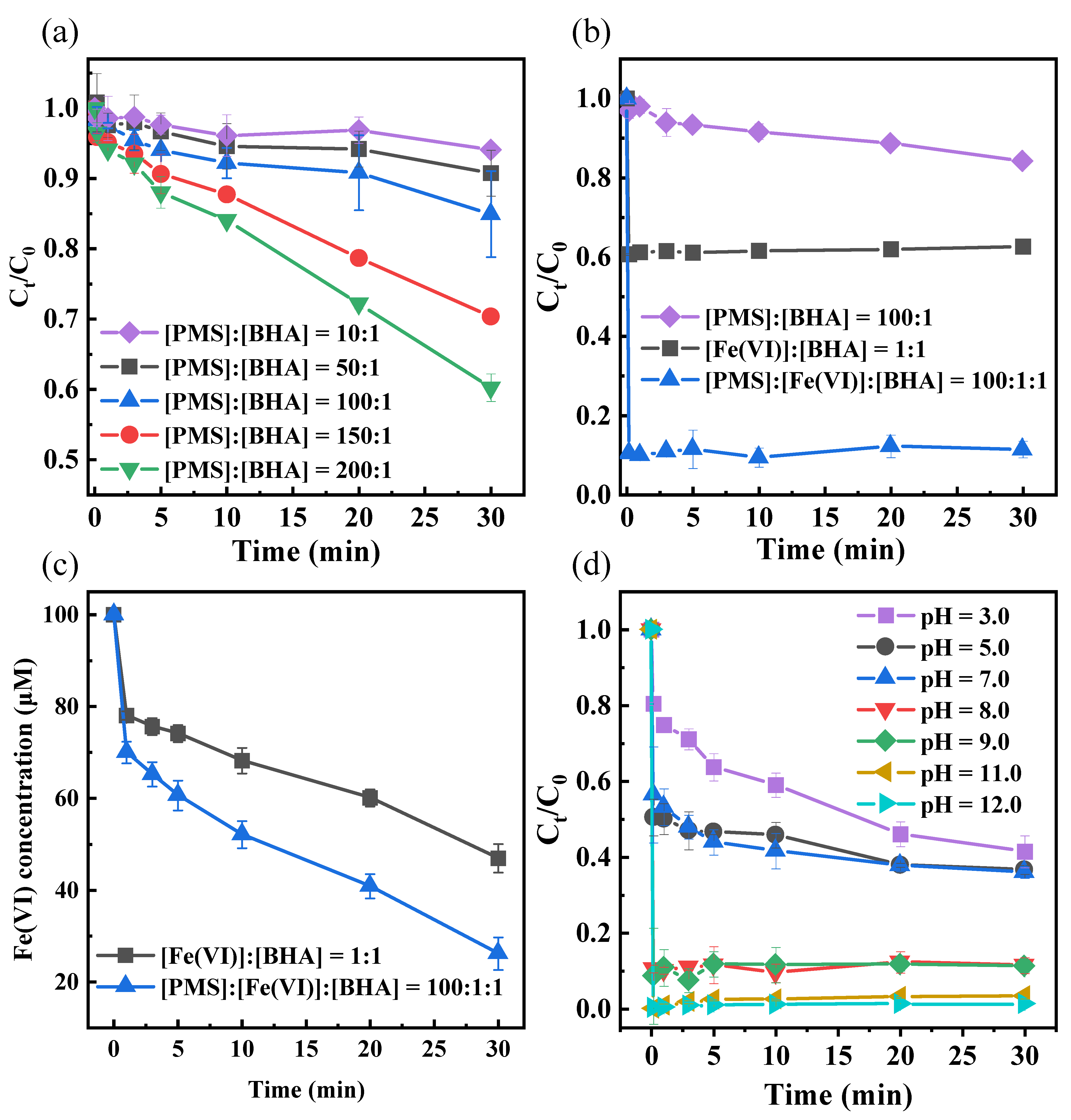
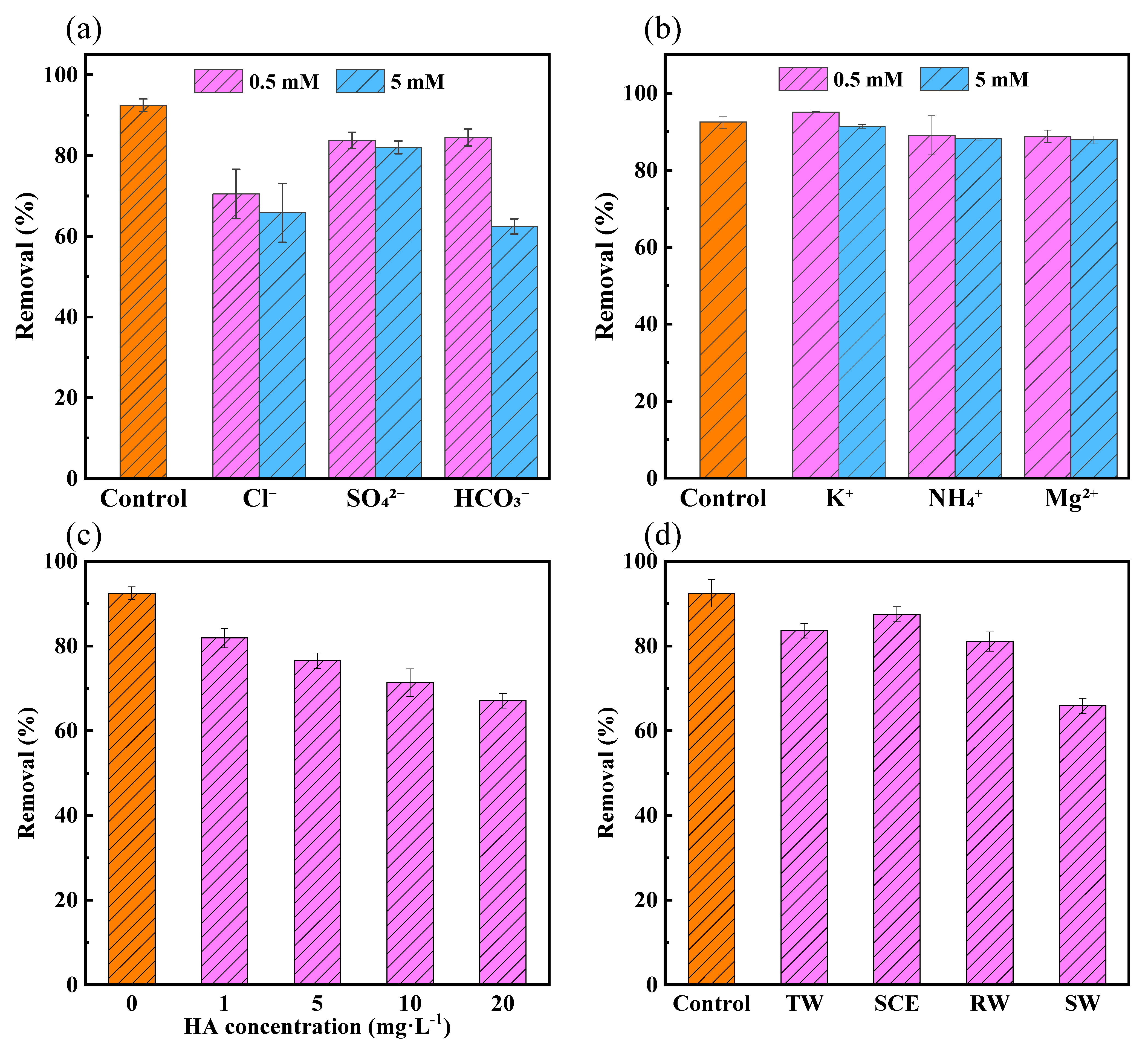
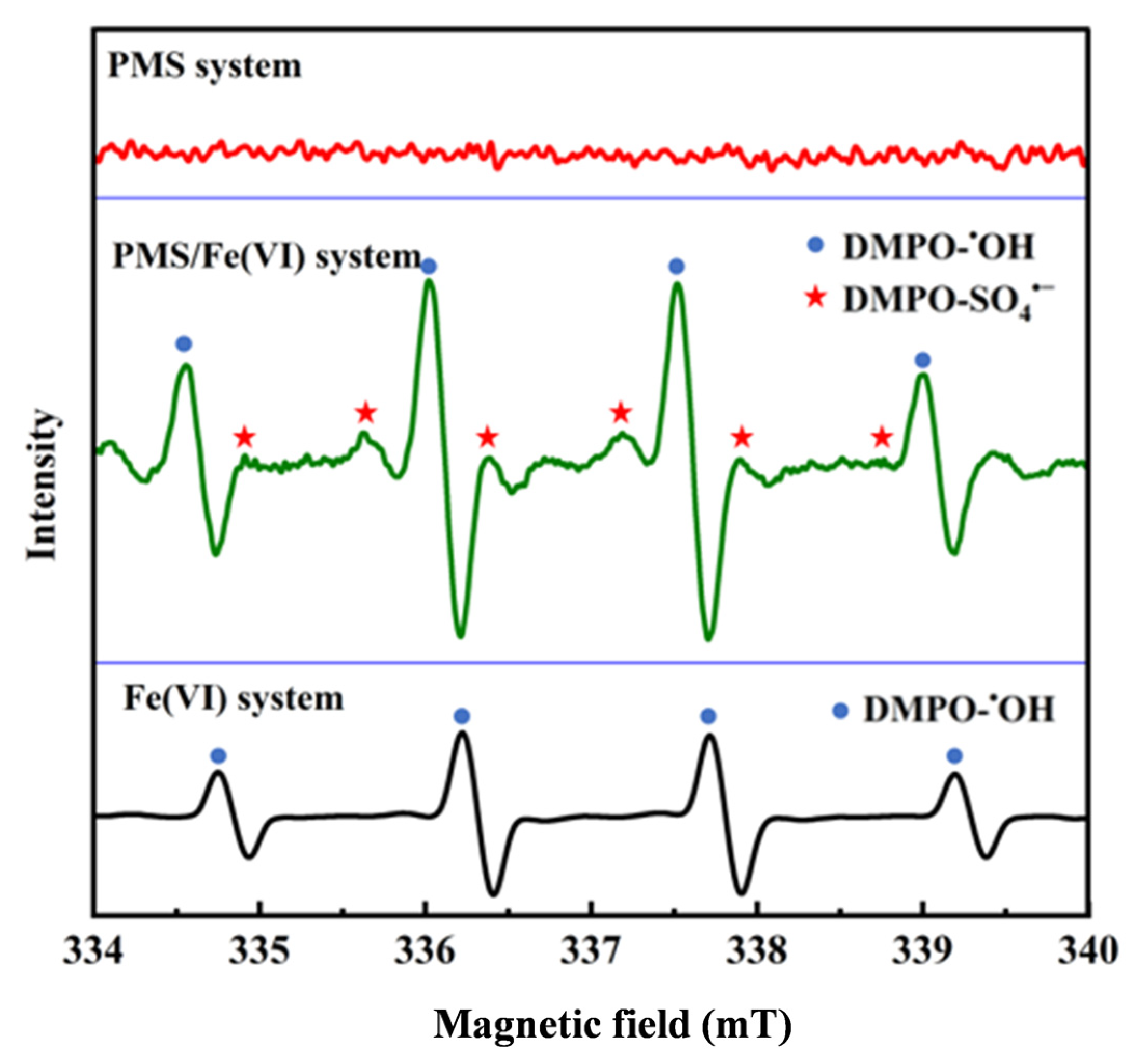
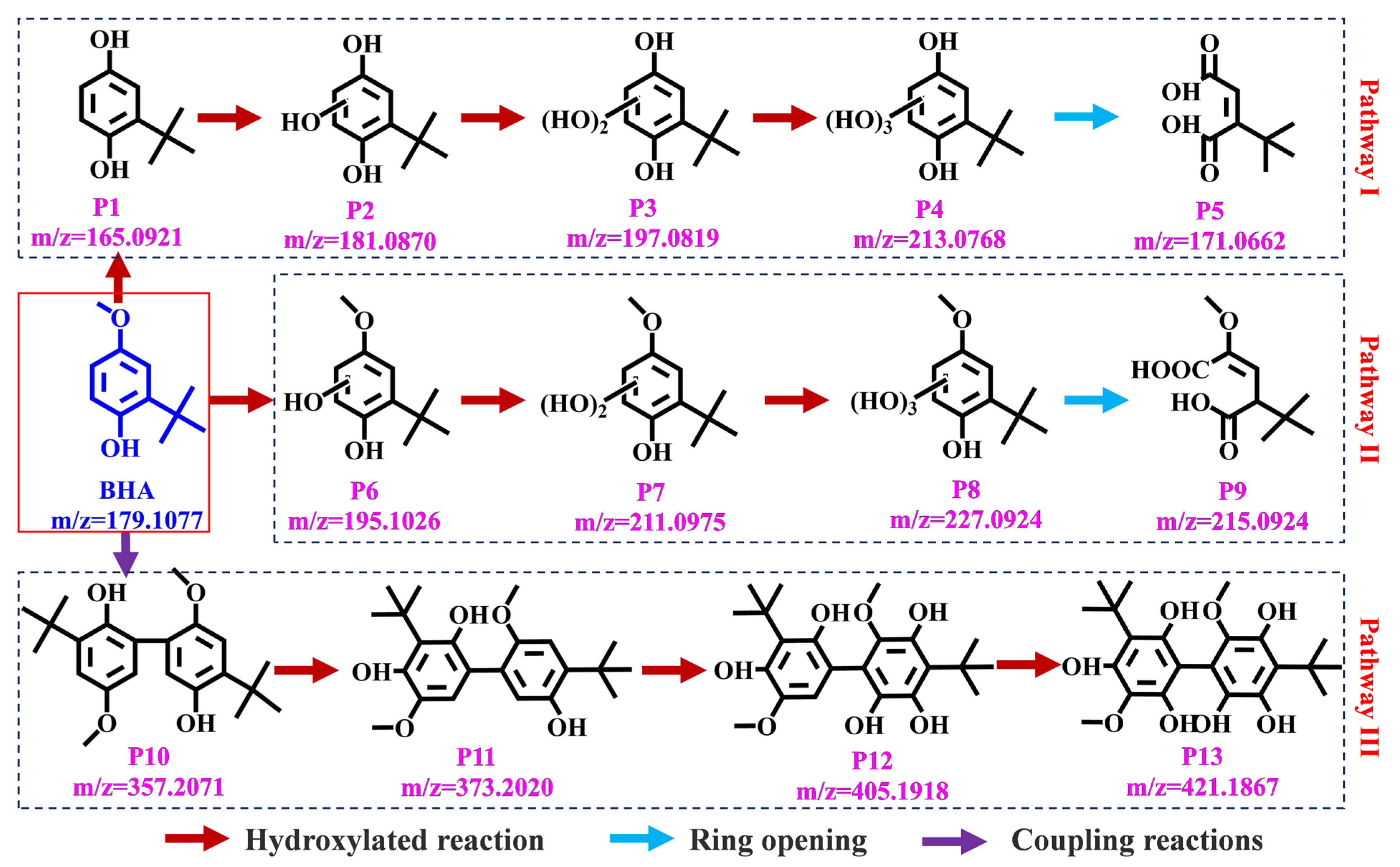
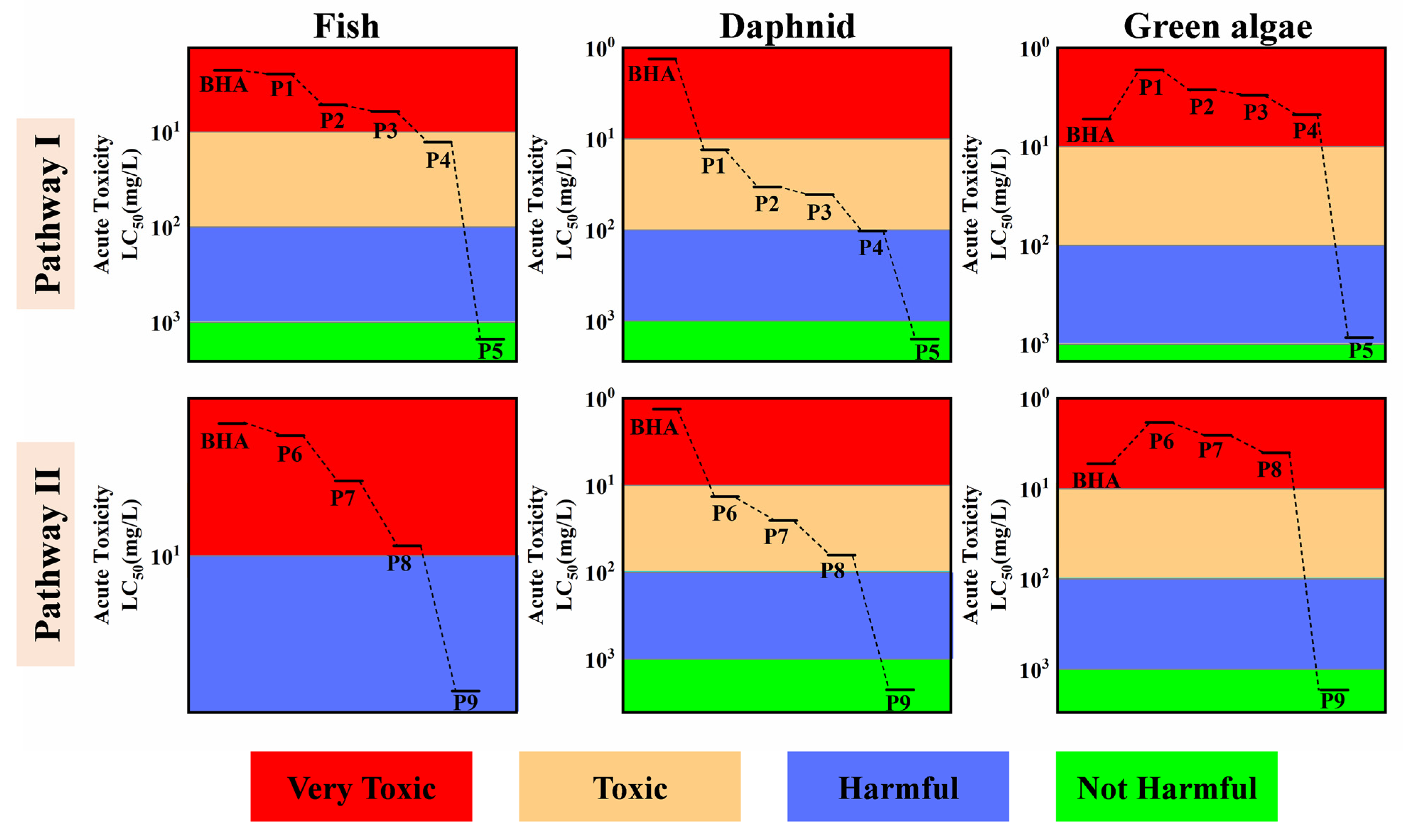
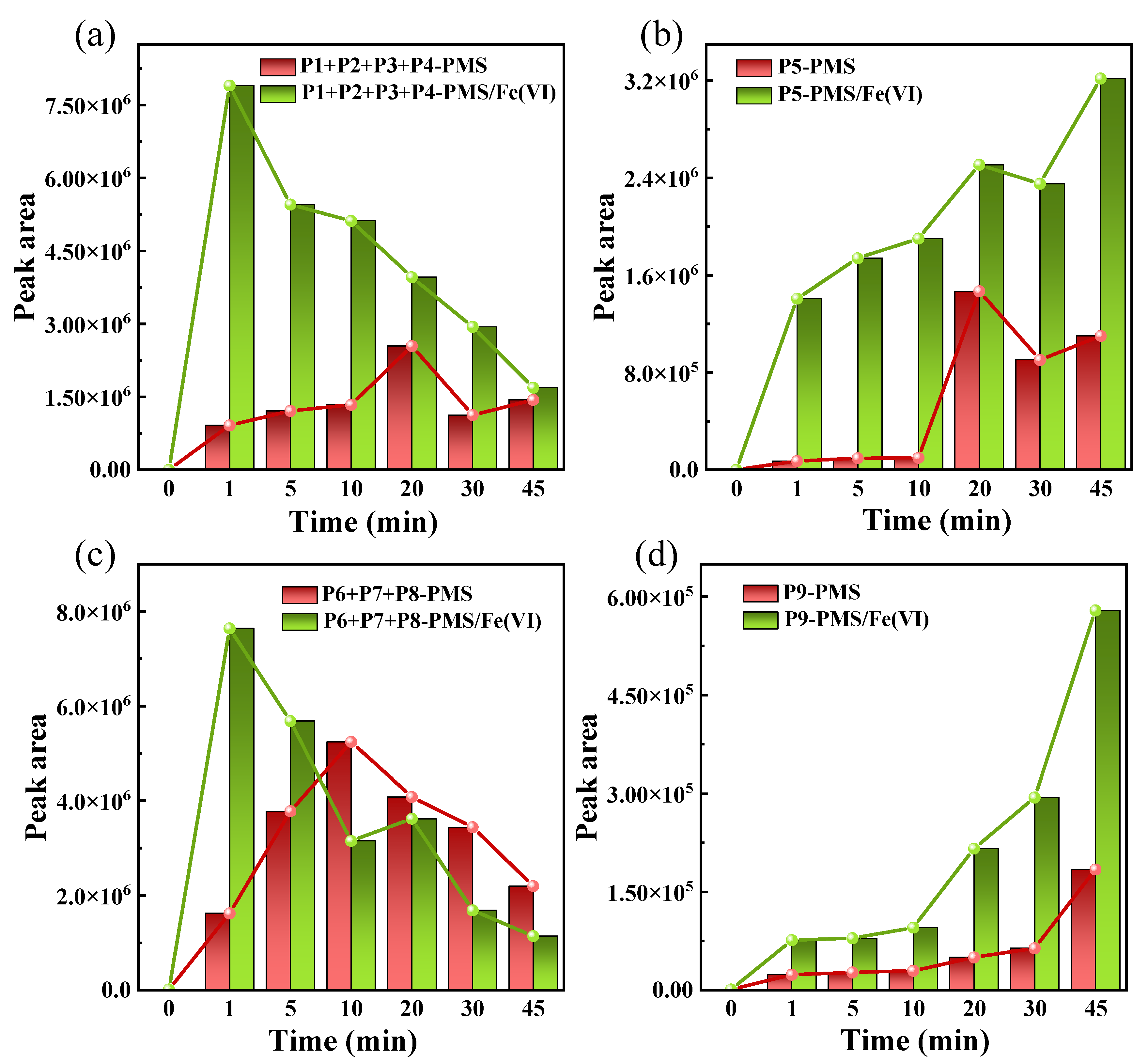
Disclaimer/Publisher’s Note: The statements, opinions and data contained in all publications are solely those of the individual author(s) and contributor(s) and not of MDPI and/or the editor(s). MDPI and/or the editor(s) disclaim responsibility for any injury to people or property resulting from any ideas, methods, instructions or products referred to in the content. |
© 2024 by the authors. Licensee MDPI, Basel, Switzerland. This article is an open access article distributed under the terms and conditions of the Creative Commons Attribution (CC BY) license (https://creativecommons.org/licenses/by/4.0/).
Share and Cite
Shi, P.; Yue, X.; Teng, X.; Qu, R.; Rady, A.; Maodaa, S.; Allam, A.A.; Wang, Z.; Huo, Z. Degradation of Butylated Hydroxyanisole by the Combined Use of Peroxymonosulfate and Ferrate(VI): Reaction Kinetics, Mechanism and Toxicity Evaluation. Toxics 2024, 12, 54. https://doi.org/10.3390/toxics12010054
Shi P, Yue X, Teng X, Qu R, Rady A, Maodaa S, Allam AA, Wang Z, Huo Z. Degradation of Butylated Hydroxyanisole by the Combined Use of Peroxymonosulfate and Ferrate(VI): Reaction Kinetics, Mechanism and Toxicity Evaluation. Toxics. 2024; 12(1):54. https://doi.org/10.3390/toxics12010054
Chicago/Turabian StyleShi, Peiduan, Xin Yue, Xiaolei Teng, Ruijuan Qu, Ahmed Rady, Saleh Maodaa, Ahmed A. Allam, Zunyao Wang, and Zongli Huo. 2024. "Degradation of Butylated Hydroxyanisole by the Combined Use of Peroxymonosulfate and Ferrate(VI): Reaction Kinetics, Mechanism and Toxicity Evaluation" Toxics 12, no. 1: 54. https://doi.org/10.3390/toxics12010054
APA StyleShi, P., Yue, X., Teng, X., Qu, R., Rady, A., Maodaa, S., Allam, A. A., Wang, Z., & Huo, Z. (2024). Degradation of Butylated Hydroxyanisole by the Combined Use of Peroxymonosulfate and Ferrate(VI): Reaction Kinetics, Mechanism and Toxicity Evaluation. Toxics, 12(1), 54. https://doi.org/10.3390/toxics12010054







